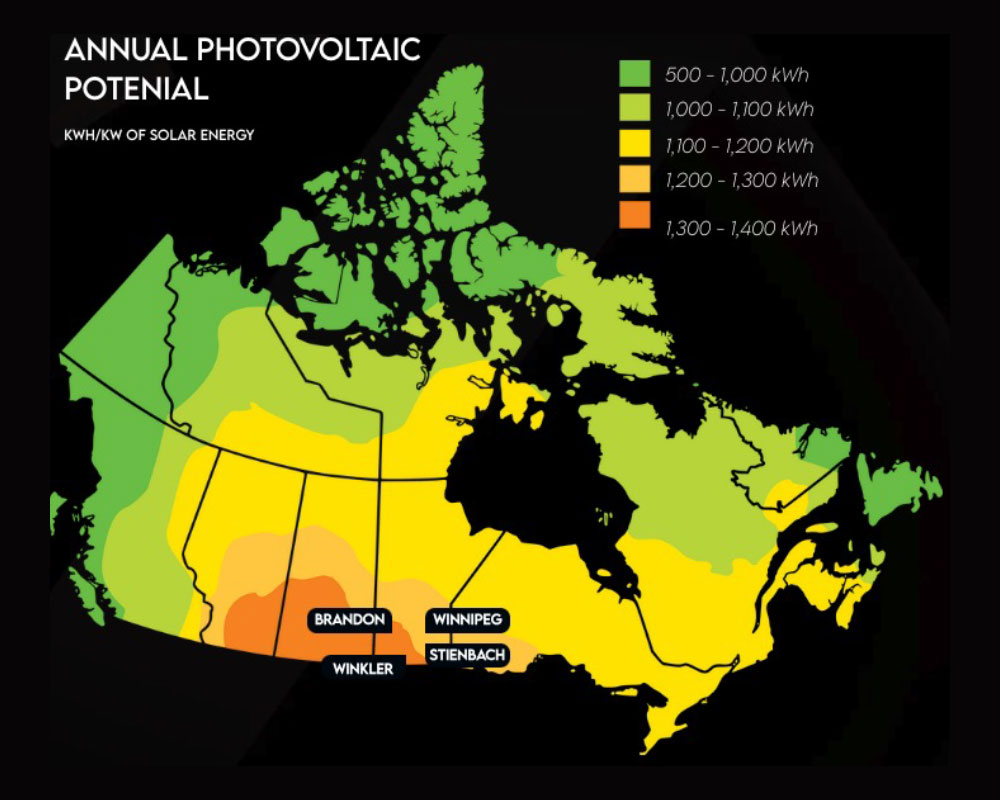There are numerous factors that determine how much power a solar system will produce at any moment in time, over the course of a day or throughout its entire lifespan.
Factors That Influence Solar Power Production
Sunlight Intensity (or Irradiance)
Solar power generation is completely dependent on the amount of solar energy that your panels receive. Solar panels cannot produce electricity when there is no irradiance (ie. at night) and they produce the most electricity with direct sunlight. Throughout the course of a day, sunlight intensity is usually at its highest during “peak sun hours”.
Solar electricity is produced during “off-peak” hours but the majority of solar power generation takes place during a 3 to 6 hour window in the middle of the day. The number of peak sunlight hours on any given day varies throughout the year and is largely dependent on geographic location and local weather conditions.
Southern Manitoba is among the best locations in Canada for total annual sunlight hours!

Solar Panel Wattage
Within the world of solar panels, there are many difference products on the market with varying capabilities.
A solar panel’s wattage rating relates to the amount of power it could potentially output in ideal operating conditions. As electricity is measured in watt-hours (Wh), a 400-watt solar panel would then be able to theoretically produce 400 watt-hours of solar power over the course of a single hour.
In 2024, a majority of Astra Solar installs have been done with either 410 watt or 550 watt solar panels.
Solar Cell Efficiency
“Efficiency” in solar panels is often confused. All 400 watt solar panels have the exact same power production capability, 400 watts. However certain brands or models may be able to produce 400 watts with less overall footprint vs. another – this is “efficiency”. Higher efficiency solar panels are higher quality and more expensive upfront.
Over the course of a solar panel’s lifetime, its efficiency will slowly degrade. This degradation is slow – all solar panels Astra Solar installs are guaranteed by warranty to maintain at least 85% of their production efficiency through 25 years of operation or more.
Solar Panel Placement
Where you install your solar panels will also dramatically affect the amount of solar power your system can produce. Because solar panels are mounted to a fixed location for their lifetime, picking the optimal placement for your array is important to maximize your power production.
The ideal placement of a solar in Manitoba is directly south, at an angle of between 20 and 45 degrees. While east and west-facing panels can still generate significant amounts of solar power, south-facing panels are optimal as they capture as much daily sunlight as possible during peak sun hours.
Shading
Minimizing potential shade on your panels is the best way to ensure that you have a productive solar system. Shade on solar panels can be caused by many things, the most common of which are neighbouring trees, neighbouring houses, chimneys, dormer windows and snow cover.
All Astra Solar roof mounts are done with “micro inverters”. With a micro inverter system, shading on one panel does not affect any of the surrounding solar modules!
Temperature
Ambient temperatures will also affect how efficiently a solar panel can convert sunlight to usable electricity. As with a lot of technology, solar panels actually prefer cooler conditions over hot ones. This is a major reason why solar panels thrive in Manitoba. With lots of sunshine and mild temperatures, Manitoba is a hot spot for solar energy!
Do you want to see what you can be saving with solar?
About Astra Solar
Astra Solar exists because we believe our greatest resource, the sun, is under-utilized. Driven by our vision to lead Manitoba in its pursuit of renewable energy for a stronger, healthier and more sustainable community, Astra Solar delivers solutions that make solar energy and vehicle charging infrastructure affordable and accessible to all Manitobans.

